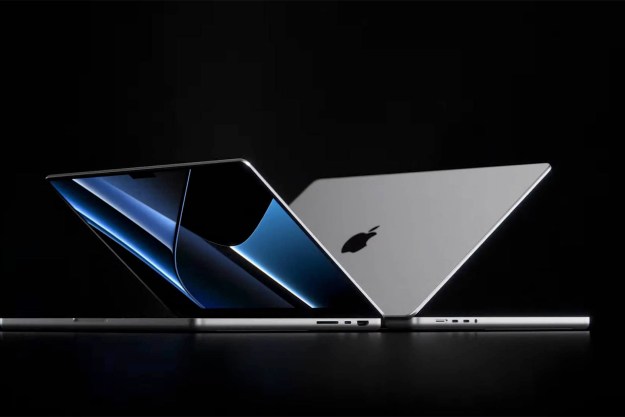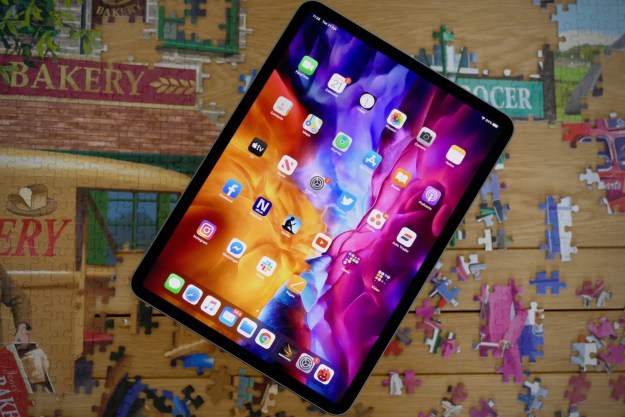“The QuickCam Pro for Notebooks proves an excellent option for those looking for a powerful and user-friendly webcam.”
- Excellent image clarity; very good low-light performance; fun add-ons
- Slow camera movement and updating in low light; cheap-feeling stand
Summary
Logitech’s new webcams boast Carl Zeiss lenses and a host of snappy-named imaging technologies. But the especially recommended model QuickCam Pro for Notebooks offers all the bells and whistles of larger, more cumbersome webcams, only in a smaller, more stylish package. With plenty of options to choose from, what separates this particular model from the pack? Read on to find out.
Features and Design
Webcams have quickly transitioned from whiz-bang, high-tech peripherals to your average, run-of-the-mill gadgets, built into systems as standard pack-ins that are easy enough for grandma to operate. If your laptop doesn’t have one integrated already, and your monitor lacks a lens, there are further plenty of bargain cameras from major manufacturers and no-name outlets available to fill the void. So if you’re looking for a simple, cheap and purely functional unit, stop reading here. Chances are that a premium webcam like the QuickCam Pro for Notebooks is well beyond anything you need. However, if you’re looking for something a little more robust and dependable, don’t be afraid to continue.
But first, a little background: Logitech recently introduced a revamped line of webcams sporting updated imaging technologies, glass lenses and Carl Zeiss optics. If this was just an attempt to get the company’s name back in circulation via hyperbole-laden press releases, it didn’t attract much attention. Nonetheless, we come to praise, not bury the manufacturer though, despite its lack of public relations savvy. Considering that the firm’s original product line was extremely capable on its own, a re-release of spiffier, more capable cams could only mean a noticeable upgrade in quality from everyday shoppers’ standpoint. And, indeed, as hands-on time with the QuickCam Pro for Notebooks quickly reinforces, this definitively proves to be the case.
Mind you, the gizmo isn’t without faults. For example, it comes with a three-piece stand, a soft carrying pouch and accompanying software CD. But the stand feels uncharacteristically flimsy for a Logitech product – it does not securely snap into place and the plastic appears thin and fragile – despite serving its purpose as a place to mount the camera permanently in the event that a laptop owner doesn’t want to clip or un-clip it with each use. Then again, on the bright side, the neoprene carrying pouch looks to be of top quality, though it fits only the camera itself.
The QuickCam Pro for Notebooks also has a straightforward form factor that sees it snap right on to the top edge of a laptop screen or monitor. While not tiny, the webcam takes up little space and attaches easily. Unlike some other screen-mounted cameras, which force you to tilt your monitor or use your own ingenuity to aim it correctly, the Pro for Notebooks further has the ability to tilt on its own. Granted, there is no side-to-side adjustability, but the included software will zoom and then reframe the screen, creating a virtual pan and tilt of the camera. While this isn’t an ideal situation for would be Internet celebrities, the native 2MP resolution does mean it can get away with some zooming and cropping without too much distortion.
Image Courtesy of Logitech
Testing and Use
The associated software suite feels refined and smooth, even in Windows Vista, and shows off the sophistication we’ve come to expect from a longtime player in the peripheral market. Installation is flawless, and all functions work well out of the box, with the exception of panning and tilting features, which take some time to get used to. Recently taken pictures are easily accessible, as are various resolution settings; post-picture actions, such as email and printing, prove easy enough to utilize; and swapping picture and movie modes couldn’t be more effortless.
Of course, working in the dark has been a problem for past Logitech cams, and unfortunately, this one isn’t much different in that regard, as far as automatic settings go. In low light situations with high front lighting, like nighttime use above a bright monitor, we found that manually setting the low light options worked markedly better than utilizing the unit’s RightLight technology’s default recommendations. (When we flipped the switch to manual settings, it took around 15 seconds to adjust the camera to produce a much more crystal clear, well-balanced image.) Once that hurdle is overcome though, image quality is much improved over most webcams we’ve seen, which we presume is due to better internal sensors and optics.
Your favorite reviewer, Brandon King
One of the much-touted features that Logitech has bundled into their recent QuickCams is the ability to overlay avatars and props that move with the video input. The initial calibration routine needed to utilize these options takes seconds, and asks the user to line up their facial features to a series of dots, which serve to anchor parts of the avatar image. The result is good, old-fashioned self-deprecating fun. You can even replace the entire image with one of five preinstalled avatars, or add props like a fake mustache. There are also several filters that warp and distort the geometry and colors of the image, as well as “video masks” which create a Jay Leno-esque effect by only showing your mouth and eyes moving atop a static image. In addition to the couple dozen options built in, there are hundreds more available online for download.
I have joined the Borg collective
A Picaso of yours truly
Moving on, the camera’s built-in microphone does a respectable job of picking up sound. There are several decent performing echo cancellation techniques offered that add only slight distortion as well. When the camera or microphone is active, a red LED illuminates, though for more stealthy operations, the LED can be completely disabled. Actions like video blogging, uploading pictures and adding video to eBay auctions are also easily facilitated by an optional Vista gadget. The only suggestion we could make for improvement here is to allow several custom profiles so that bypasses of automatic settings and preferred tweaks to image parameters could be saved and then quickly recalled in different environments.
One last thing worth noting: There are several similar products by Logitech with the same or near-identical names, such as the QuickCam for Notebooks Pro, a different beast entirely. As of publication, the correct model should prominently display the Carl Zeiss Optics indicator on the front, back and side of the box.
Conclusion
The Logitech QuickCam Pro for Notebooks is a little bit pricey for a webcam, but with 2MP native resolution and Carl Zeiss optics fueling enhanced performance, image quality is notably good. Avatar and overlay packs add a little oomph to the overall package not offered by one else but Apple, and the software feels refined and responsive. While the unorthodox panning and tilting technique is slightly annoying, most users won’t find much use for the feature anyway. The QuickCam Pro for Notebooks proves an excellent option for those looking for a powerful and user-friendly webcam.
Pros:
• Excellent image clarity
• Very good low-light performance
• Fun add-ons
Cons:
• Slow camera movement and updating in low light
• Cheap-feeling stand
Editors' Recommendations
- The 10 best monitors for 2024: tested and reviewed
- 9 best 2-in-1 laptops in 2024: tested and reviewed
- The XPS 16 is fighting an uphill battle against the MacBook Pro
- Best 14-inch laptops for 2024: tested and reviewed
- 10 best gaming monitors of 2024: tested and reviewed








